What is Sucre à la Crème?
To me, sucre à la crème is the utmost indulgence. It’s a simple and pure and S-W-E-E-T fudge! The literal translation of sucre à la crème is “sugar with cream” and that is just about all there is to it. With only four, very readily available ingredients – brown sugar, white sugar, heavy cream and butter – the key to this recipe comes in how you put these four ingredients together. There is one key tool that is relatively important to the recipe (or at least makes it much easier to make) – a candy thermometer. It’s an inexpensive and worthwhile investment and a good addition to your kitchen arsenal.
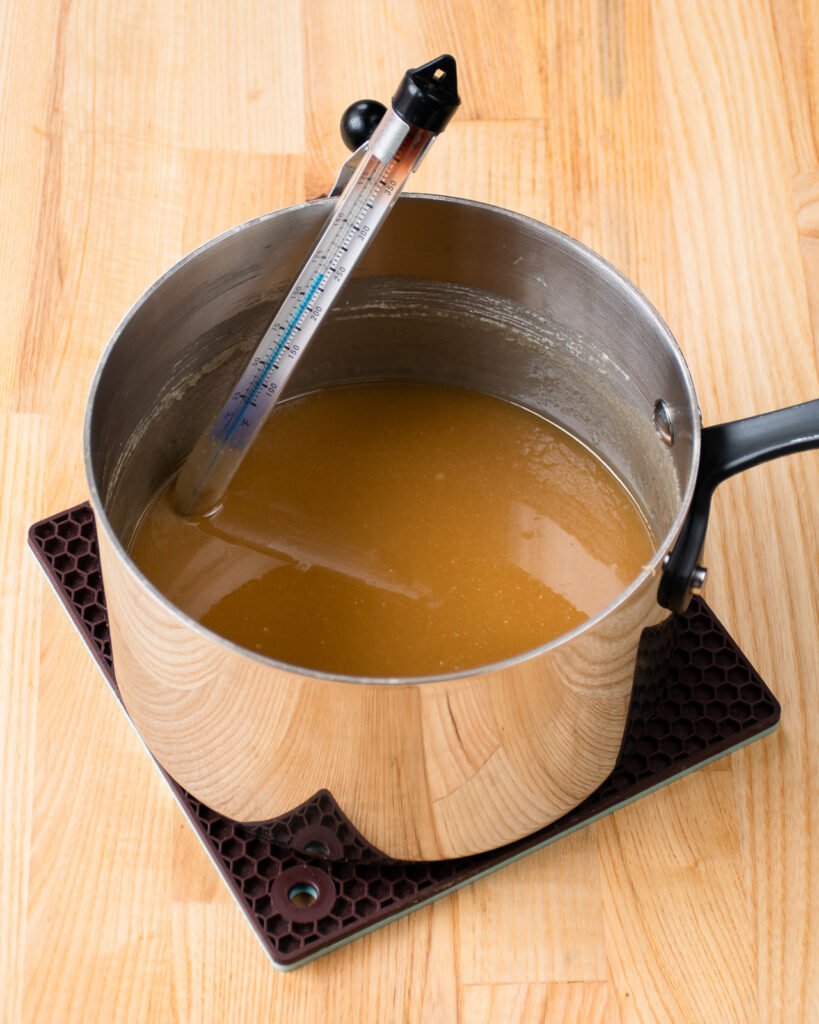
Canadian Fudge
The only trick to making this fudge variation is to watch temperatures – and when I say “watch”, I mean don’t walk away from the stove when you’re doing this. You want to bring the sugar to “soft ball” stage, which is around 235ºF to 240ºF. Soft ball stage (not to be confused with softball stage, which might have been those teenage years when baseball just seemed too hard to play) is the temperature at which sugar will form a soft, squish-able ball when dropped into cold water. Understandably, it’s much easier to test this with a thermometer than by dropping a little sugar into an ice bath and pinching it with your fingers. The sugars and cream will boil away as the mixture comes to this temperature, which is when you want to stand by for a couple of reasons. First of all, it’s a terrible mess to clean up if you let the mixture boil over. Secondly, you want to make sure you remove the pot from the stovetop as soon as it reaches 240ºF and not let it go over 240ºF.

Key Temperature for Sucre à la Crème
Then, it is key to let the mixture cool to about 110ºF. If you just let the sugars and cream sit in the saucepan on the stovetop, this could take as long as 45 to 60 minutes. That’s no big deal if you’re making a day out doing things in the kitchen, but if you want to cool it a little faster, transfer the mixture to a bowl and place it in a cool water bath. Then, it’s time to start beating air into the mix. When you begin to beat, the mixture will have a glossy sheen – pay attention to that.
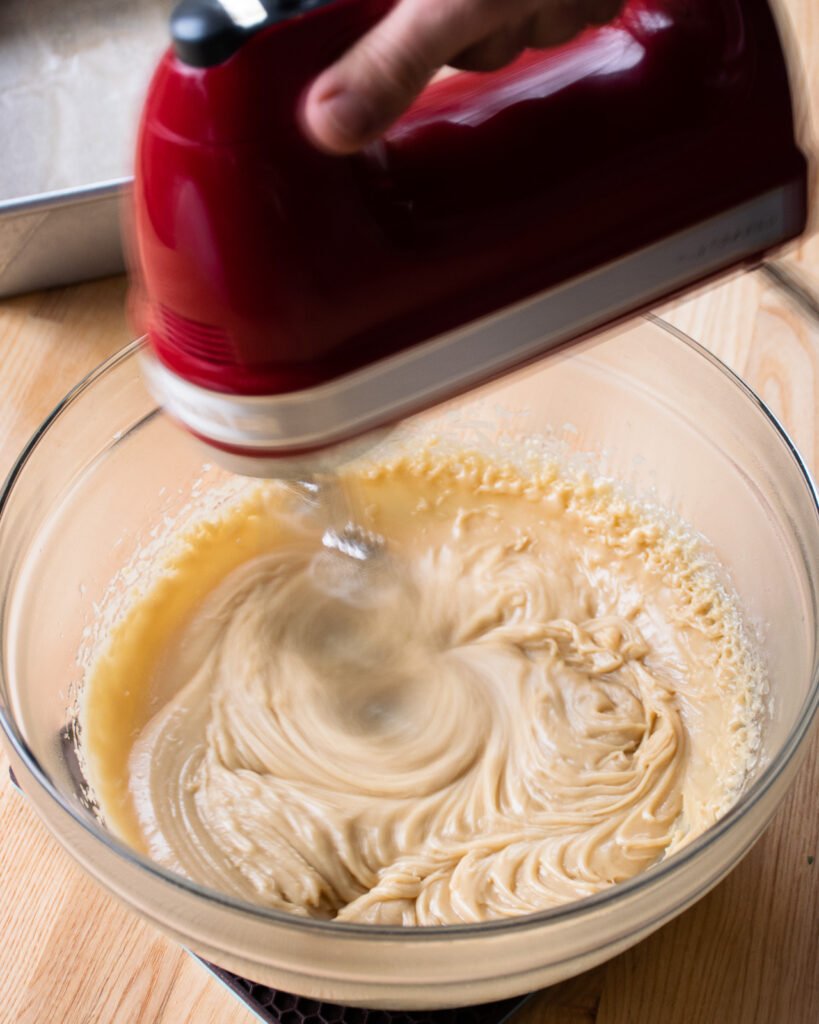
Beating the Sucre à la Crème
Pay attention because as you beat (and what you want to watch for this to happen) the mixture will lose its glossy look, take on a lighter color and become more opaque. The beaters will leave a trail behind them as they beat – that’s the first sign you’re getting close.
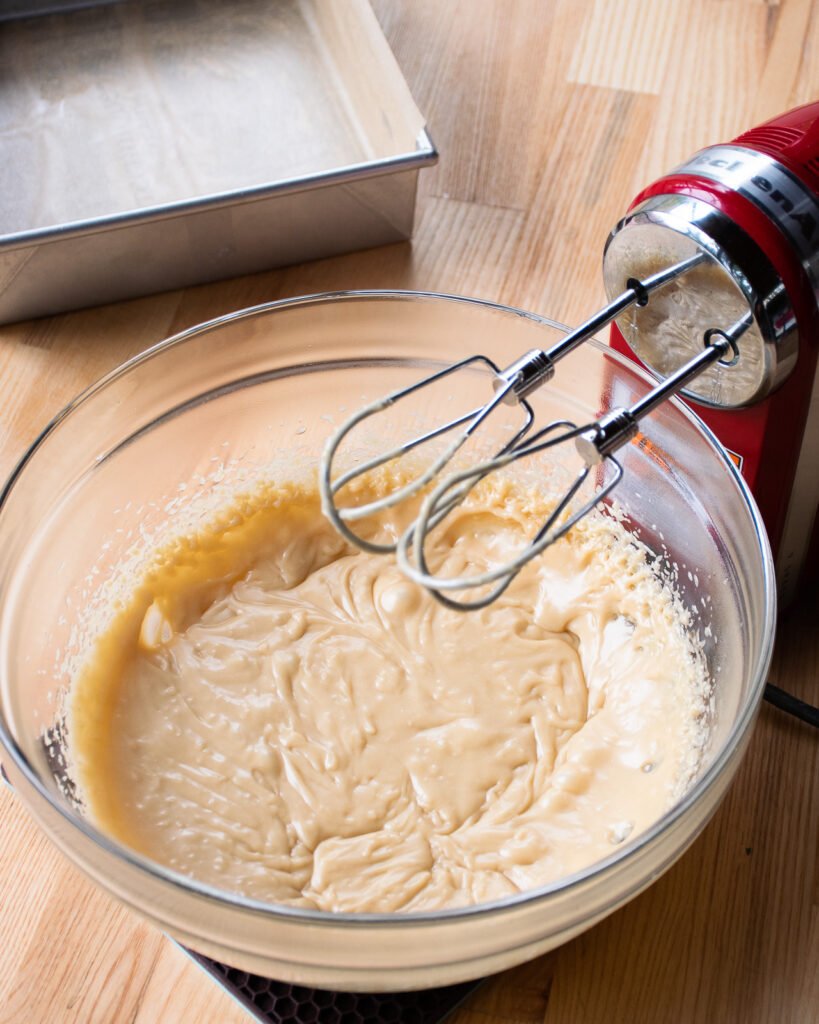
Know When to Stop
It is somewhat important to know when to stop beating the mixture and unfortunately experience is the best teacher in this regard. The goal is to stop while the mixture is still pourable. If you beat it too much, it will thicken too much and you won’t be able to pour it into your cake pan, but don’t despair. If this happens to you, you can spoon and spread the mixture into the cake pan, pushing the fudge into all four corners of the pan. You’ll know to beat it for a minute or two less next time.
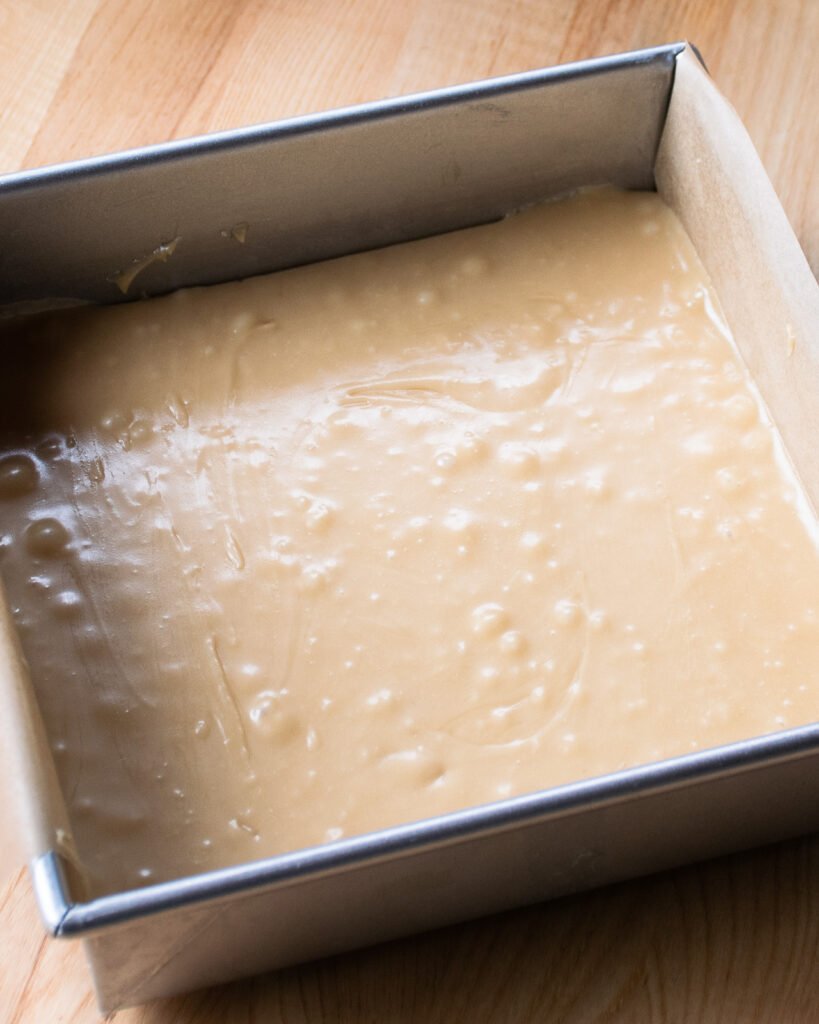
Chilling and Setting Fudge
Then, let the fudge sit in the refrigerator for a couple of hours. It will set into a fairly firm layer and if you’ve remembered to line your cake pan with parchment paper, you should be able to remove it from the cake pan relatively easily.
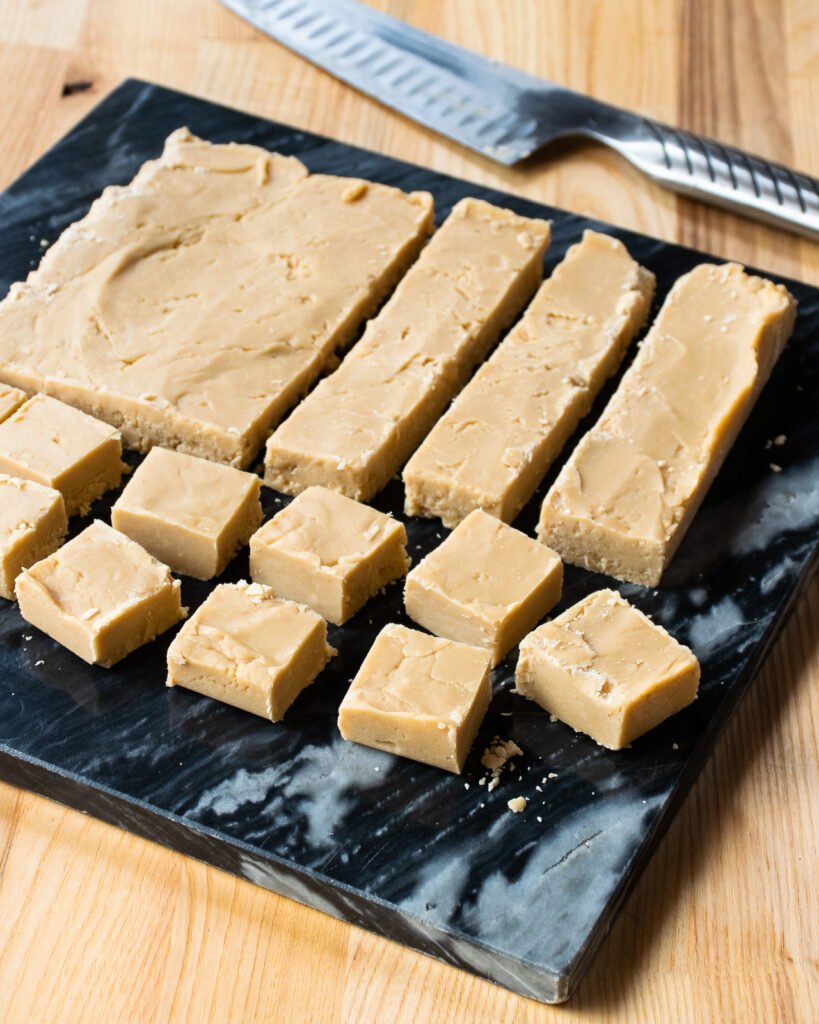
Cutting the Sucre à la Crème
Cut it into 36 little squares. Trust me, you really don’t want the pieces to be bigger than this. Sucre à la crème is so intense and so rich and sweet that a little goes a long way. I’ve only ever been able to eat one or two pieces at a time (ok…maybe three).
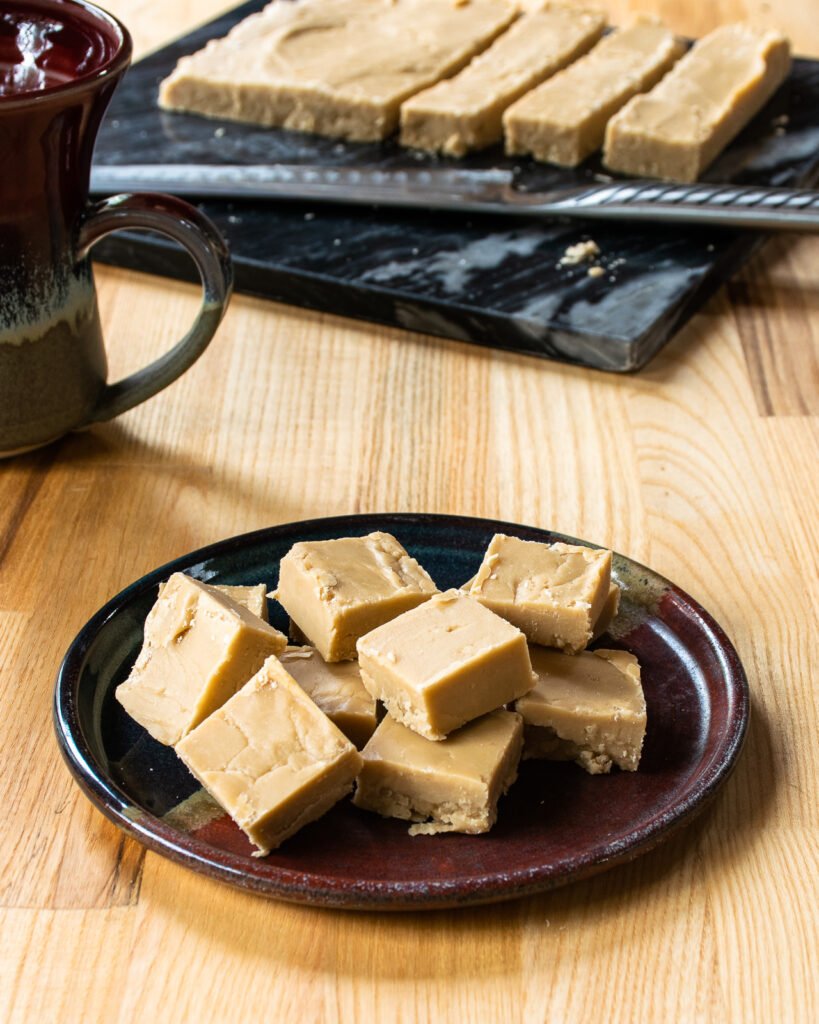
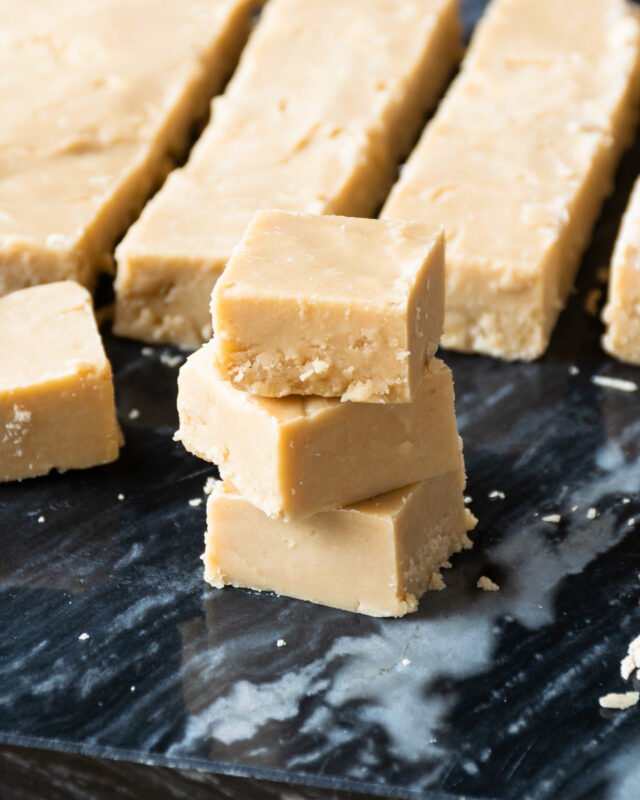


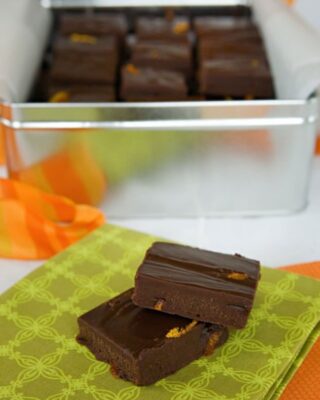
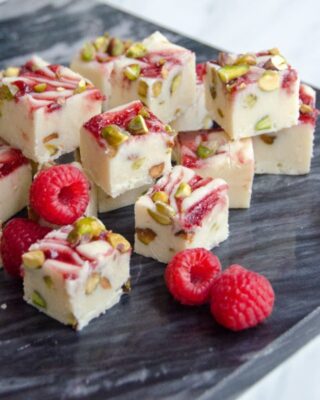
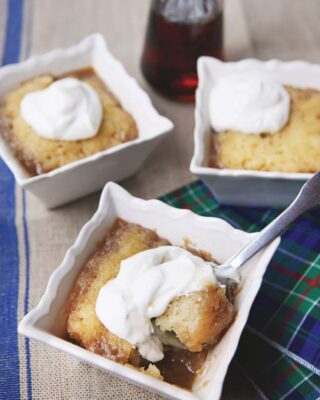
I did something wrong – it was grainy and did not really set up even after being in the fridge overnight. A couple of questions – is 235 degrees hot enough, or does it need to get to 240? Should it stay on medium-low heat the entire time, or after the sugar finally dissolves should the heat be turned up? All suggestions are welcome and appreciated!
Hi Brian. Many people say that the sugar needs to get to 238 degrees. I push it to 240 degrees to make sure and to account for inaccuracies in thermometers. It doesn’t have to be on medium-low heat, but if you turn the heat up make sure you don’t leave the stovetop. It’s important to make sure you take the pot OFF the heat right at 240ºF and it’s important to let the fudge cool to 110ºF before you start beating it. Then, make sure you beat it until you really can see a change in the appearance and texture of the fudge. I prefer to beat it too much than to beat it too little. Too little and it will not set enough to be picked up. Too much and you can still press it into a cake pan to set further. Hope that helps a little.
Tried for a holiday treat and will make it a tradition. Reminded us of candies purchased on trips to parts of Canada and brought back great memories. The recipe was spot on and we highly recommend it.
I made this recipe just as descriibed. Meredith is not jjoking about not having it around all year. This fudge is delicious. I gave some to my brother, now this fudge is all he thinks of!!!! The taste is excellent and the recipe is an easy one. Thanks Meredith. I will make this again.
Should the brown sugar be packed? Thanks.
Yes. Brown sugar measurements are always packed brown sugar (at least in all of my recipes). 🙂
ML
I think this is what my Granny made. But she stirred it, I don’t think she had a mixer. I can still hear the sound as she would make fudge…as she would stir it a certain way to get it to cool and set…want to make it and see if the taste is the same. Hugs, Di
Can you make it chocolate? If so, how?
Hi June. Sucre à la Crème is always just plain like this. If you wanted to make chocolate fudge, check out this recipe: https://bluejeanchef.com/recipes/basic-chocolate-fudge/
Did I miss what is done with 2 tblsp. Butter? Is that just for greasing the pans? Not for in the fudge?
You add the butter in Step 4. After the sugar has cooled, add the butter and beat until the mixture is no longer glossy.
Is this the same as penuche?
I hadn’t heard of penuche until you asked. I looked it up and it sounds very similar.
I would love to add walnuts. When should I add them? Or do you ever add nuts?
Sucre à la Crème is always left plain, but you can add nuts if you want to make a variation. I would stir toasted nuts in at the very end before you put it in the pan to set up.
Can you add nuts to this recipe??
Sucre à la Crème is always left plain, but you can add nuts if you want to make a variation. I would stir toasted nuts in at the very end before you put it in the pan to set up.
Meredith I was so happy to get this recipe and just as happy to see you! I bought many items over the years on QVC because I trusted in things you would indorse. Now I have internet I can follow you here. Thank you!
Thank you Barbara!
I am really happy to see this recipe..I think this is a recipe my grandpa used to make..I have the handwritten recipe but it is so old You cant make out the ingredients. Grandpa Marshall used to call this penuche…I am also a QVC fan and miss You terribly…I purchased the little Cooks Essential pressure cooker you presented..Hoping You will return to QVC someday..Happy to follow You here though..Thank You, Peggy
I’m anxious to try this recipe because my mother ( French Canadienne) made this every year starting at Thanksgiving and sent it all over to friends, etc. she called it Boston Cream Loaf and it had condensed milk and only white sugar along with light syrup. It tastes the same, maybe because it is an American new England variation?
Hi Anne, I am not familiar with that recipe. This recipe is the traditional French Canadian recipe and the only way I have made it. I hope you like this version!
born and raised in canada i grew up with this recipe. my mom sometimes would substitute real maple syrup for brown sugar.
My cooked mixture was too hard to beat! It was like thick toffee and I had to heat it up again just to get it out of the pot. Did I over cook it? I took it off the heat right at 240 but had it on medium heat. Thanks for your help.
Hi Danièle. I’m afraid I don’t know exactly what happened, but it sounds like too much liquid evaporated, making your fudge too stiff to beat. That could happen if you over-cooked the sugar and cream so you might check your thermometer to make sure it is calibrated properly (hold it in boiling water and make sure it reads 212ºF). I hope you managed to heat the mixture a little to get it to the point where you could beat it.
to add to my previous comment: I was following another recipe that asked for 2 cups of brown sugar and 3/4 cup cream. so the proportions were different than in your recipe.
I’ve been looking for a Sucre à crème recipe that was just like my mèmère’s, unfortunately I didn’t get it from her but I knew from the look of this sucre à crème that it was the one.
Let me say as a traditional French Canadian this recipe is fantastic. I was a bit worried while beating it after letting it cool, it looked like it was separating. I think it just cooled down very fast and I pressed it into my pan and tasted some of the cooled bits, absolutely delicious!
Thank you so much!
My mom used to make penuche once a year at Christmas. This reminded me of it! Very sweet, very yummy. She’d give it away and all we’d get were the pan crumbs!!
Is it supposed to be a caramel texture when it’s cooled down? Mine was like that, was hard to poor it in a bowl, but then added the butter (3tbs) because I used whipping cream. Didn’t have heavy cream anywhere. Even though I mixed it all together, it was still a caramel texture, but then I turned around for a minute or so and came back to it, it was starting to set. I hope that when it’s fully set, that it stays together. Tasted exactly like sucre à crème.
The texture should be firm and set up when it has cooled, but still have a soft consistency. Heavy cream and whipping cream have a close enough fat content that it should not have effected the consistency.
My Pépère would make plain and with nuts. He would chop nuts fine and put in the bottom of the pan before pouring the fudge over it.
I have been making fudge for over thirty years now. A tradition passed on from my mother, and have always used her recipe and somewhat her technique. (Mom used a wooden spoon, I use my beater) Today is fudge making day and I thought I’d check out some other recipes just out of curiosity. As I came across this one I see it is very much similar,as they all are, since it’s basically sugar and cream. However, my recipe does call for two other ingredients, that being 1tbsp corn syrup and 1tsp vanilla. I really wanted to commend you on your directions. I very much agree it does take experience, and you’ve written them based on that, I’ve had quite a few flops in my years. Since I consider myself quite experienced I started experimenting, i substituted half the cream with Bailey’s Irish cream, and it was amazing, and I’ve since used most of their seasonal flavors as well to treat my co workers, pumpkin spice, red velvet etc
All but Pina colada because I just can’t imagine that one.
Thanks again for awesome directions, and Happy holidays, off to make fudge! 😀
This is the recipe my mom made for years. Only difference is she used evaporated milk instead of cream and it was our job to beat it with a wooden spoon. Best part was cleaning off the spoon and any sugars left in the pan!
I (tried) to make a similar recipe but with real maple syrup. The stove I was using is older and it took forever ( a freaking hour!😩) to get to the soft ball stage. Well, it’s more like taffy than fudge. Is it because it just cooked way too long ? I tried reheating it but nope it’s now taffy. I know now to make the burner hotter but it’s too late for this batch unfortunately
Sorry you had a problem with your recipe. Maybe you would have better luck with Meredith’s recipe using brown and granulated sugar instead of maple syrup. It has been tested several times.
i was so happy to find this recipe —i was given it years ago and by practice i figured your great directions especially the going from glossy to dull –what i learned is letting it cool to 110 –can’t wait to try –getting it NON grainy was always hit and miss for me
The recipe I saw didn”t have any peanut butter in it………
This recipe is not for peanut butter fudge and doesn’t call for peanut butter. Here is the link if that is what you are looking for: https://bluejeanchef.com/recipes/peanut-butter-fudge/
What do I grease the parchment paper with?
I would grease the pan and the parchment paper with butter.
Absolutely delicious.going to make recipe with grandaughter as Christmas gifts.
My daughter is trying to make this recipe but we live in the states & not sure what cream to use. In Canada they have the 35%. She grew up with her aunt making sucre creme as her father is french canadian.
Thank you!
You can buy heavy cream in the states which has at least 36% fat content.